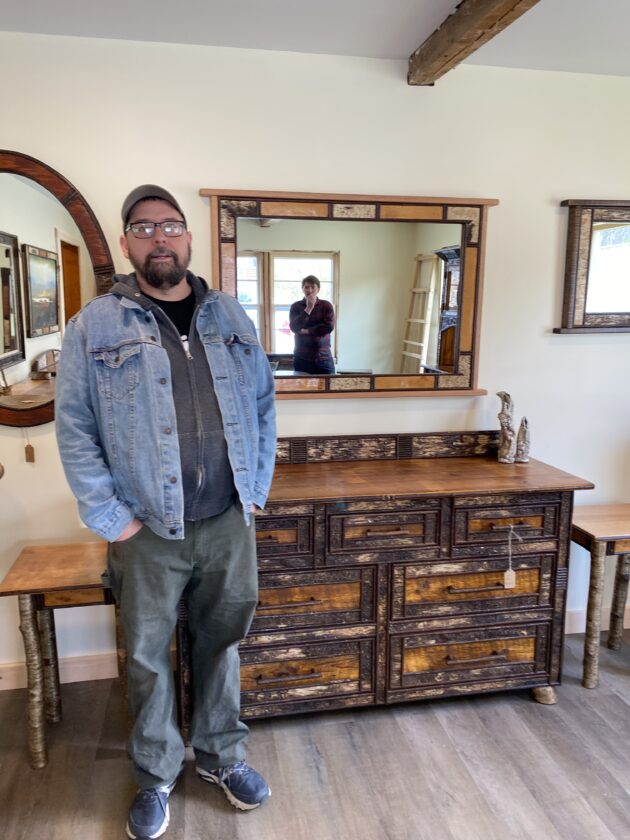Keenan Family Rustic Furniture keeps tradition alive

Ted Keenan stands in the display room of Keenan Family Rustic Furniture. His son Justice is reflected in the mirror behind him. (Provided photo — Martha Allen)
KEENE — A fresh paint job and new signage are drawing attention to what looks like a new furniture business here. In reality, said Ted Keenan, proprietor, “We’ve been working on it for four years.” The business is taking off and coming into its own.
The sign, clearly visible to those driving on the state road between Keene and Lake Placid, reads “Keenan Family Rustic Furniture.” The name is significant.
“A lifetime of knowledge is transmitted through generations.There are classes, but you can’t go to school for it. Generational artisan skills are handed down. Gate-kept information must be handed down,” he explained.
Many of his tables are built on a base of fantastically gnarled and twisting roots, often involving the root system of more than one tree. As a young boy growing up in North Creek he would dig in the gravel along an abandoned railroad track, unearthing roots of trees that had grown there. He had no idea that someday he would be using similar roots in his future career; at the time he just found them interesting.
Keenan worked in the construction trades, entering the rustic trades with timber framing and work at the Whiteface Lodge. He learned rustic furniture making from George Jaques of Keene Valley, who, Keenan said, was a great influence and a help to him. Jaques himself learned the art from his uncle Gib Jaques, a well-known Adirondack artisan. Keenan went to work for George Jaques when Jaques agreed to head the woodshop at Dartbrook Rustic Goods in Keene.
When Jaques and Dartbrook parted ways, Keenan stayed on for a time as woodshop head. Then, after making the decision to go into business for himself (the other woodworkers presented him with a birch bark crown as a going away present, which he still keeps), Keenan had to wait for a two-year noncompete agreement to expire. When reminded that the Federal Trade Commission banned noncompete agreements nationwide April 23, after he had already waited out his two years, he was good natured about it, saying that at no time did he give up on his plan to start his own rustic furniture business.
Keenan and his son Justice, 24, work closely together. Justice is, to say the least, enthusiastic about his work in the family business. About chip carving on a three-legged stool: “It’s like something really old you’d see in a trapper’s camp in the 1800s.”
He likes making finishes. Influenced by George Jaques, who made his own special wood finish using nitric acid and steel wool, Justice explained how a finish can antique wood, bringing out its shimmer and character.
He dissolves steel wool in vinegar for a flintlock rifle stock style finish, and uses linseed oil to bring out different characters in the wood.
Tiger maple, like the tiger’s eye gemstone, exhibits a shimmering iridescent luster when light hits it, an effect known in the trade as chatoyancy, he said. He also loves curly maple, and especially birdseye maple, for its charactered grain, although, he admits, it is difficult to work with.
“There is more value depending where it (a piece of furniture) is from, the history of it, all the different unique things that make it what it is,” Justice said. “I really love Japanese and Italian carving. Not so much Scandinavian style. Our work is heavier.”
Ted said that when some people complain about the cost of original hand crafted furniture, because they don’t consider all that the work entails, “what goes into every piece of work. When someone asks, How long did this take you to make? And also why does this cost so much? There is so much that goes into it. “
He cites gathering wood from an 1800s era barn that was torn down (“some places take wood and artificially age it, distressing it and calling it barnwood”), collecting willow on snowshoes — “It has to be done in the winter to preserve the bark so it stays on” — kiln-drying wood and hand-weaving splint reed for chairs and beds, just to name a few examples. And, of course, the knowledge, skill and artistry required for the designing and building of the furniture all take years to acquire.
“Our wood is solid. We don’t use veneers, no plywood, no laminates.” Collection of birch and birch bark is done sustainably and responsibly.
He said he appreciates Larry Post, proprietor of L. Post Rustics; when he displayed furniture there, “Larry Post let me have my name on my work,” a generosity that is rare in the rustic furniture business, where artisans’ work is often displayed and sold anonymously.
This anonymity, Keenan believes, “robs artists of reputation and credit … if you take away the individual, then nothing has any value.”
“We don’t sell anything anywhere but here,” he said. This is because they want to be known for the furniture they create. Another reason is that the building of rustic furniture is so time consuming and expensive that splitting profit from sales with a middle man is simply not practicable.
“We never shut up about furniture,” Ted said, remarking that sometimes, as father and son sit discussing their work, one of them will suddenly become aware that they have been talking until the wee hours.
“It’s like a bug that gets into me,” Justice said. “I can’t get it out of my head day or night.”
